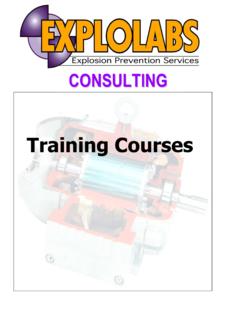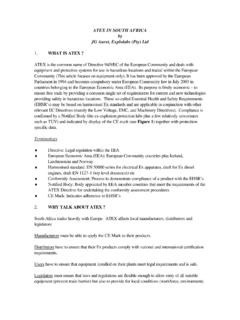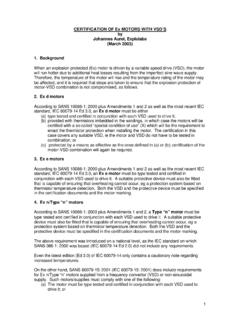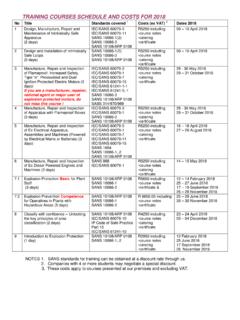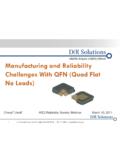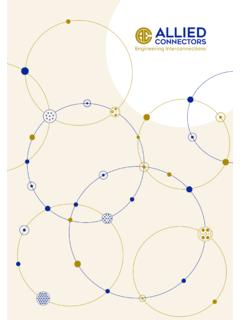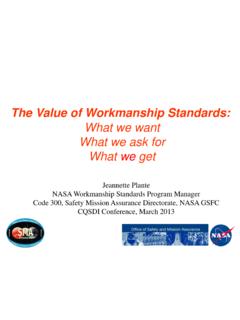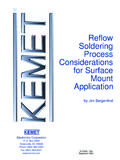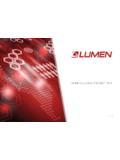Transcription of Instrumentation in Hazardous Locations - …
1 1 Instrumentation in Hazardous Locations : Framework for plant management by Johannes Auret, Explolabs 1. Introduction This article deals with explosion protection relating to instruments installed in Hazardous Locations . Explosion protection is a complex subject but is rarely covered in technical syllabi. Plant staff therefore has to rely on knowledge gained from published literature and some scattered courses and may struggle to gain a comprehensive view of explosion protection concepts. A framework for managing Instrumentation in Hazardous Locations should address all the aspects mentioned in the following.
2 2. Selection of equipment An explosion protected instrument as shown above does not per se provide safety. Two aspects are to be determined during a process known as the classification of the Hazardous location: The level of protection required and the ignition characteristics of the atmosphere. The level of protection (officially called the Equipment Protection Level or EPL) provided by typical explosion protection concepts applied to Instrumentation for gas or vapour atmospheres varies as follows: Intrinsic safety Ex i Zone 0 (category ia), Zone 1 (category ib) Flameproofing Ex d Zone 1 Pressurization Ex px Zone 1 (with automatic interlocks) (Note that this relationship between EPL and zone can be changed in certain cases due to a particular risk.)
3 2 Besides the explosion protection concepts mentioned above, other concepts used for instruments and instrument junction boxes include non-sparking Ex nA, increased safety Ex e and dust-ignition-protected Ex tD. This information is provided in national standard SANS 10108. The ignition characteristics of the explosive atmosphere is expressed as the subgroup (I for underground mines; IIA, IIB or IIC for gases and IIIA, IIIB or IIIC for dusts) and the ignition temperature (temperature class T1 to T6 for gases and layer and cloud ignition temperature for dusts).
4 The subgroup relates to the energy involved in igniting or extinguishing the explosive atmosphere with a spark. In the case of flameproof apparatus, for example, the physical dimensions of joints in the enclosure are increased to improve the cooling ability of such joints when a flame resulting from an internal explosion passes through them (see sketch below left). The energy that can be released by an electronic circuit is determined by its resistive, capacitive and inductive energy converting capability during normal operation or under fault conditions; an intrinsically safe design ensures that safe energy levels will not be exceeded under such conditions (see sketch below right).
5 The above paragraphs illustrate that an explosion protected instrument will not provide safety unless it matches the explosive gas, vapour or dust atmosphere to which it is to be exposed ! Also, not all explosion protected equipment will have legal status. SANS 10108 refers to ARP 0108 that clearly defines certification requirements. In essence, the design of explosion protected equipment has to be verified for compliance with a suitable standard, while the production process of such equipment must be controlled (by means of quality management) to ensure that each unit is produced to this design.
6 Certification systems that effectively cover these two aspects (type testing and production control) are included in ARP 0108. An example of an IA certificate for successful type testing is shown below (even imported Ex equipment must be accompanied by such a certificate). 3 The onus is in the first instance on the supplier to ensure that his apparatus meets the above requirements. Information supplied must cover certification, installation, use, maintenance and repair of his equipment. 3. Installation of equipment Connections to enclosures and cables The cable connection to apparatus must complement the explosion protection.
7 The normal rule is to use like with like, ie a flameproof cable gland must be used with apparatus with a flameproof enclosure, and an increased safety gland with apparatus with an increased safety enclosure, etc. Technicians are often getting this wrong where techniques are used in combination on the same apparatus or where the apparatus has double certification. Examples are North American instruments that may be flameproof ( explosion proof ) as well as intrinsically safe, and European Ex e d or Ex d ib instruments.
8 In the same vein, the plugging of unused openings is a trap for the unwary. Often, a flameproof or increased safety enclosure with a press-in plastic plug or conduit/water plug, or a gland sealed with a piece of sponge is found. Attention to detail is literally of life-saving importance. Cables (together with cable installation methods and glands) are chosen to be resistant to mechanical damage and chemical attack, to provide protection against ingress of moisture and dust through the cable and also, in the case of flameproof enclosures, to prevent propagation of an explosion.
9 As the purpose of an installation in a Hazardous location is to prevent ignition of an explosive atmosphere by means of sparks, arcs and/or heat, the correct electrical rating, earthing and bonding, screening and the presence of a working electrical protection system is extremely important. Many industrial cables complying with a suitable standard meet these requirements. Instrumentation cable for intrinsically safe circuits must at least provide an insulation resistance of 500 V core-to-core. Specific conditions of use Certain Ex equipment comes with so-called specific conditions of installation or use.
10 For instrument installations, this may involve the connection of flying leads inside a suitably protected connection box, limiting programmable units to certain values or providing protection against impact or dust/moisture ingress by means of an enclosure. Such conditions, without which the explosion protection is not fully functional, are either indicated by an instruction on the equipment, or where lack of space does not permit this, an X after the certificate 4 number marked on the apparatus label.
